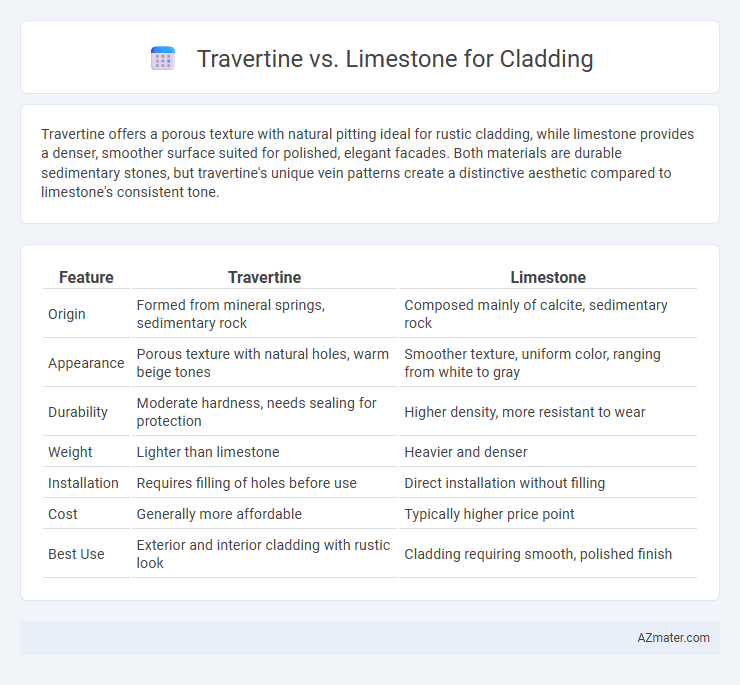Travertine offers a porous texture with natural pitting ideal for rustic cladding, while limestone provides a denser, smoother surface suited for polished, elegant facades. Both materials are durable sedimentary stones, but travertine's unique vein patterns create a distinctive aesthetic compared to limestone's consistent tone.
Table of Comparison
| Feature | Travertine | Limestone |
|---|---|---|
| Origin | Formed from mineral springs, sedimentary rock | Composed mainly of calcite, sedimentary rock |
| Appearance | Porous texture with natural holes, warm beige tones | Smoother texture, uniform color, ranging from white to gray |
| Durability | Moderate hardness, needs sealing for protection | Higher density, more resistant to wear |
| Weight | Lighter than limestone | Heavier and denser |
| Installation | Requires filling of holes before use | Direct installation without filling |
| Cost | Generally more affordable | Typically higher price point |
| Best Use | Exterior and interior cladding with rustic look | Cladding requiring smooth, polished finish |
Introduction to Travertine and Limestone Cladding
Travertine and limestone are popular choices for cladding due to their natural beauty and durability. Travertine features a porous, fibrous texture formed from mineral deposits in hot springs, offering a warm, earthy tone ideal for both interior and exterior surfaces. Limestone, composed mainly of calcium carbonate, provides a smoother, more uniform appearance with excellent resistance to weathering, making it a versatile option for architectural facades.
Geological Formation and Composition Differences
Travertine forms through rapid precipitation of calcium carbonate from mineral-rich hot springs, resulting in a porous, banded texture with visible cavities, while limestone is a sedimentary rock composed mainly of compacted marine skeletal fragments of calcium carbonate, exhibiting a denser and more uniform grain structure. Geological formation of travertine involves hydrothermal activity typically near volcanic regions, contrasting with limestone's gradual accumulation in shallow, warm marine environments. The higher porosity and distinct layering of travertine impact its use in cladding, offering unique aesthetic and textural qualities compared to the more consistent and durable surface of limestone.
Visual Appearance and Color Variations
Travertine cladding exhibits a distinctive porous texture with natural pitting and a warm, earthy color palette ranging from creamy whites to rich ochres, enhancing its rustic charm. Limestone offers a smoother, more uniform surface with subtle color variations including soft grays, beiges, and muted yellows, providing a classic and elegant appearance. The pronounced veining in travertine contrasts with the consistent tonal quality of limestone, making travertine ideal for dynamic visual impact while limestone suits minimalist and refined facades.
Durability and Weather Resistance
Travertine exhibits higher durability and superior weather resistance compared to limestone, making it an ideal choice for exterior cladding in harsh climates. Its dense composition and natural mineral structure provide enhanced resistance to erosion, freeze-thaw cycles, and moisture absorption. Limestone, while aesthetically pleasing, tends to be more porous and susceptible to weathering, requiring additional sealing and maintenance for long-term outdoor applications.
Installation Methods and Techniques
Travertine and limestone each demand specific installation methods to ensure durability and aesthetic appeal in cladding projects. Travertine requires filling its natural voids with resin or grout before installation, typically using thin-set mortar for secure adhesion on vertical surfaces. Limestone, being denser, allows for direct application with mortar or adhesive, often necessitating mechanical fixation for heavy panels to prevent slippage and maintain structural integrity over time.
Maintenance and Cleaning Requirements
Travertine cladding requires more frequent sealing to prevent water absorption and staining, while limestone is more porous and demands careful cleaning with mild, pH-neutral solutions to avoid surface etching. Both materials should be cleaned regularly to remove dirt and prevent mold growth, but travertine's denser composition allows for easier stain resistance compared to limestone. Proper maintenance protocols for each stone enhance durability and aesthetic appeal in exterior or interior cladding installations.
Cost Comparison: Travertine vs Limestone
Travertine generally costs more than limestone due to its unique porous texture and natural veining that require specialized quarrying and processing techniques. Limestone offers a more budget-friendly option with a wide range of durability and finish variations, making it suitable for both interior and exterior cladding. Installation costs for both materials are comparable, but travertine's higher material price often leads to increased overall expenses for cladding projects.
Sustainability and Environmental Impact
Travertine and limestone cladding both originate from natural sedimentary rock formations, yet travertine's unique porous structure allows for less energy-intensive processing, making it a slightly more sustainable choice. Limestone extraction often involves extensive quarrying, which can lead to significant ecological disturbance and habitat destruction. Travertine's long lifespan and minimal maintenance requirements contribute to its reduced environmental footprint compared to limestone, which may need more frequent repairs or sealing.
Popular Applications in Modern Architecture
Travertine and limestone are widely used for cladding in modern architecture due to their natural elegance and durability. Travertine is favored for its textured surface and warm, earthy tones, making it popular in upscale residential and commercial facades, as well as pool surrounds. Limestone, known for its smooth finish and subtle color variations, is commonly applied in corporate buildings, historical restorations, and minimalist design projects seeking a sophisticated, timeless appearance.
Choosing the Best Stone for Your Cladding Project
Travertine offers a unique porous texture and warm earth tones, making it ideal for exterior cladding that demands natural beauty and durability. Limestone provides a smooth, dense surface with a variety of neutral shades, perfect for sleek, modern facades requiring strong resistance to weathering. Selecting between travertine and limestone depends on project-specific factors such as aesthetic preference, climate conditions, and maintenance needs to ensure optimal long-term performance.

Infographic: Travertine vs Limestone for Cladding
 azmater.com
azmater.com